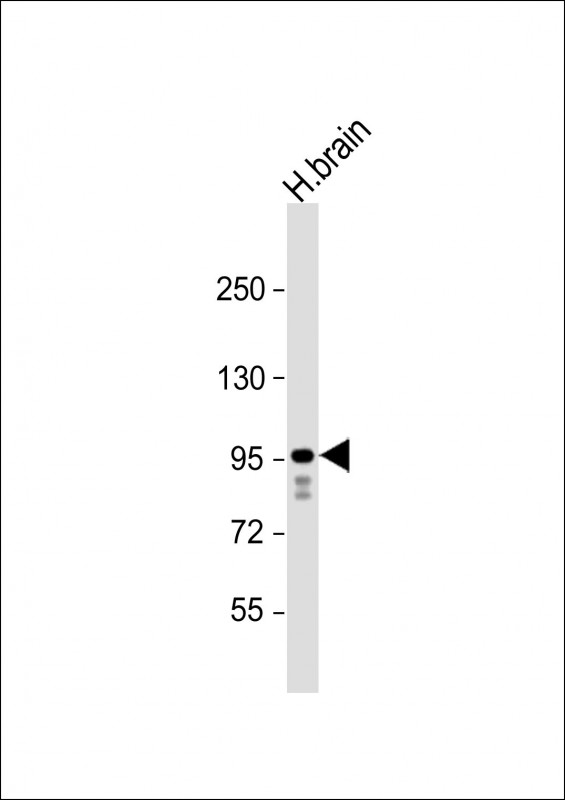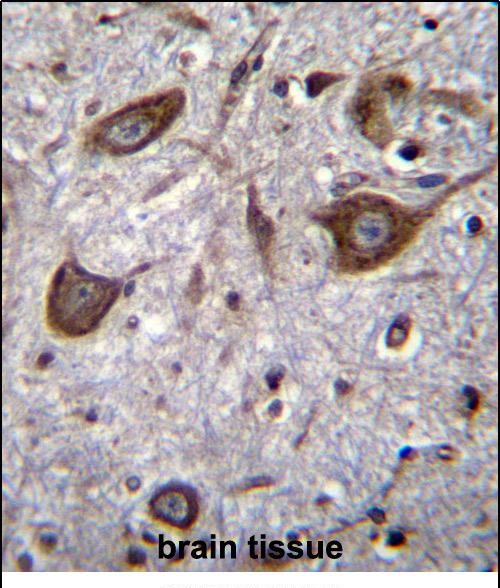GRIA4 Antibody (Center)
Affinity Purified Rabbit Polyclonal Antibody (Pab)
- 产品详情
- 文献引用 : 1
- 实验流程
- 背景知识
Application
| WB, IHC-P, E |
|---|---|
| Primary Accession | P48058 |
| Other Accession | P19493, Q9Z2W8, Q38PU5, NP_000820.3 |
| Reactivity | Human, Rat, Mouse |
| Predicted | Monkey, Rat |
| Host | Rabbit |
| Clonality | Polyclonal |
| Isotype | Rabbit IgG |
| Calculated MW | 100871 Da |
| Antigen Region | 296-325 aa |
| Gene ID | 2893 |
|---|---|
| Other Names | Glutamate receptor 4, GluR-4, GluR4, AMPA-selective glutamate receptor 4, GluR-D, Glutamate receptor ionotropic, AMPA 4, GluA4, GRIA4, GLUR4 |
| Target/Specificity | This GRIA4 antibody is generated from rabbits immunized with a KLH conjugated synthetic peptide between 296-325 amino acids from the Central region of human GRIA4. |
| Dilution | WB~~1:1000 IHC-P~~1:100~500 E~~Use at an assay dependent concentration. |
| Format | Purified polyclonal antibody supplied in PBS with 0.09% (W/V) sodium azide. This antibody is purified through a protein A column, followed by peptide affinity purification. |
| Storage | Maintain refrigerated at 2-8°C for up to 2 weeks. For long term storage store at -20°C in small aliquots to prevent freeze-thaw cycles. |
| Precautions | GRIA4 Antibody (Center) is for research use only and not for use in diagnostic or therapeutic procedures. |
| Name | GRIA4 {ECO:0000303|PubMed:29220673, ECO:0000312|HGNC:HGNC:4574} |
|---|---|
| Function | Ionotropic glutamate receptor that functions as a ligand- gated cation channel, gated by L-glutamate and glutamatergic agonists such as alpha-amino-3-hydroxy-5-methyl-4-isoxazolepropionic acid (AMPA), quisqualic acid, and kainic acid (By similarity). L-glutamate acts as an excitatory neurotransmitter at many synapses in the central nervous system and plays an important role in fast excitatory synaptic transmission (By similarity). Binding of the excitatory neurotransmitter L-glutamate induces a conformation change, leading to the opening of the cation channel, and thereby converts the chemical signal to an electrical impulse upon entry of monovalent and divalent cations such as sodium and calcium. The receptor then desensitizes rapidly and enters a transient inactive state, characterized by the presence of bound agonist (By similarity). In the presence of CACNG8, shows resensitization which is characterized by a delayed accumulation of current flux upon continued application of L-glutamate (PubMed:21172611). |
| Cellular Location | Cell membrane {ECO:0000250|UniProtKB:P19493}; Multi-pass membrane protein {ECO:0000250|UniProtKB:P19493} Postsynaptic cell membrane {ECO:0000250|UniProtKB:P19493}; Multi-pass membrane protein {ECO:0000250|UniProtKB:P19493}. Cell projection, dendrite {ECO:0000250|UniProtKB:P19493}. Postsynaptic cell membrane {ECO:0000250|UniProtKB:P42262}; Multi-pass membrane protein {ECO:0000250|UniProtKB:P42262} |
For Research Use Only. Not For Use In Diagnostic Procedures.

Provided below are standard protocols that you may find useful for product applications.
BACKGROUND
Glutamate receptors are the predominant excitatory neurotransmitter receptors in the mammalian brain and are activated in a variety of normal neurophysiologic processes. These receptors are heteromeric protein complexes composed of multiple subunits, arranged to form ligand-gated ion channels. The classification of glutamate receptors is based on their activation by different pharmacologic agonists. The subunit encoded by this gene belongs to a family of AMPA (alpha-amino-3-hydroxy-5-methyl-4-isoxazole propionate)-sensitive glutamate receptors, and is subject to RNA editing (AGA->GGA; R->G). Alternative splicing of this gene results in transcript variants encoding different isoforms, which may vary in their signal transduction properties. Some haplotypes of this gene show a positive association with schizophrenia. [provided by RefSeq].
REFERENCES
Need, A.C., et al. Eur. J. Hum. Genet. 17(7):946-957(2009)
Volpi, S., et al. J Clin Psychiatry 70(6):801-809(2009)
Kessels, H.W., et al. Neuron 61(3):340-350(2009)
Arai, S., et al. Psychiatr. Genet. 19(1):6-13(2009)
Aruscavage, P.J., et al. RNA 6(2):257-269(2000)
终于等到您。ABCEPTA(百远生物)抗体产品。
点击下方“我要评价 ”按钮提交您的反馈信息,您的反馈和评价是我们最宝贵的财富之一,
我们将在1-3个工作日内处理您的反馈信息。
如有疑问,联系:0512-88856768 tech-china@abcepta.com.






















 癌症的基本特征包括细胞增殖、血管生成、迁移、凋亡逃避机制和细胞永生等。找到癌症发生过程中这些通路的关键标记物和对应的抗体用于检测至关重要。
癌症的基本特征包括细胞增殖、血管生成、迁移、凋亡逃避机制和细胞永生等。找到癌症发生过程中这些通路的关键标记物和对应的抗体用于检测至关重要。 为您推荐一个泛素化位点预测神器——泛素化分析工具,可以为您的蛋白的泛素化位点作出预测和评分。
为您推荐一个泛素化位点预测神器——泛素化分析工具,可以为您的蛋白的泛素化位点作出预测和评分。 细胞自噬受体图形绘图工具为你的蛋白的细胞受体结合位点作出预测和评分,识别结合到自噬通路中的蛋白是非常重要的,便于让我们理解自噬在正常生理、病理过程中的作用,如发育、细胞分化、神经退化性疾病、压力条件下、感染和癌症。
细胞自噬受体图形绘图工具为你的蛋白的细胞受体结合位点作出预测和评分,识别结合到自噬通路中的蛋白是非常重要的,便于让我们理解自噬在正常生理、病理过程中的作用,如发育、细胞分化、神经退化性疾病、压力条件下、感染和癌症。








